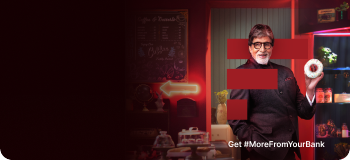CKYC Registry
-
Customer Service Contact us Service request Locate a branch
Find all the help you need
Scan the QR, get our app, and find help on your fingertips

Help CenterSupport topics, Contact us, FAQs and more
-
Login
Are you ready for an upgrade?
Login to the new experience with best features and services
-
Login
Are you ready for an upgrade?
Login to the new experience with best features and services
- Accounts
-
Deposits
IDFC FIRST Bank Deposits
View all Deposits -
Loans
IDFC FIRST Bank Loans
View all Loans - Wealth & Insure
-
Payments
IDFC FIRST Bank Payments
View all Payments -
Cards
IDFC FIRST Bank Cards
View all Cards - Blogs
- Corporate Account
-
Cash Management Services
IDFC FIRST Bank Cash Management Services
View all Cash Management Services - Supply Chain Finance
-
Corporate Lending
IDFC FIRST Bank Lending
View all -
Treasury
IDFC FIRST Bank Treasury
See more details - NBFC Financing
Support topics, Contact us, FAQs and more
- IDFC FIRST Bank Accounts
-
Savings Account
-
Corporate Salary
Account -
Senior Citizens
Savings Account -
First Power
Account -
Current Account
-
NRI Savings
Account -
TASC Institutional
Account -
Savings Account
Interest Calculator
- IDFC FIRST Bank Deposits
-
Fixed Deposit
-
Recurring Deposit
-
NRI Fixed Deposit
-
Safe Deposit Locker
-
FD Calculator
-
RD Calculator
- IDFC FIRST Bank Loans
-
Personal Loan
-
Consumer Durable
Loan -
Home Loan
-
Business Loan
-
Professional Loan
-
Education Loan
-
New Car Loan
-
Pre-owned Car Loan
-
Two Wheeler Loan
-
Pre-owned Two
Wheeler Loan -
Commercial Vehicle
Loan -
Gold Loan
-
Loan Against Property
-
Loan Against Securities
-
Easy Buy EMI card
-
Personal Loan
EMI Calculator -
Education Loan
EMI Calculator -
Home Loan
EMI Calculator
- IDFC FIRST Bank Wealth & Insure
-
FIRST Select
-
FIRST Wealth
-
FIRST Private
-
Mutual Funds
-
Sovereign Gold Bond
-
Demat Account
-
Term Insurance
-
Life Insurance
-
Health Insurance
-
General Insurance
-
Bonds
-
Loan Against
Securities -
Portfolio Management
Service
- IDFC FIRST Bank Payments
-
FASTag
-
Credit Card
Bill Payments -
UPI
-
Funds Transfer
-
Forex services
-
Pay Loan EMI
- IDFC FIRST Bank Cards
-
Ashva :
Metal Credit Card -
Mayura :
Metal Credit Card -
FIRST Millennia
Credit Card -
FIRST Classic
Credit Card -
FIRST Select
Credit Card -
FIRST Wealth
Credit Card -
FIRST WOW!
Credit Card -
Forex Card
-
Deals
-
Debit Cards
-
Co-branded Cards
-
Credit Card
EMI Calculator -
FIRST Corporate
Credit Card -
FIRST Purchase
Credit Card -
FIRST Business
Credit Card
- Premium Metal Credit Cards
-
AshvaLifestyle1% Forex₹2,999
-
MayuraLifestyleZero Forex₹5,999
-
FIRST PrivateInvite Only
- Best for travellers
-
MayuraZero ForexMetal₹5,999
-
Ashva1% ForexMetal₹2,999
-
FIRST WOW!Zero ForexTravelLifetime Free
-
FIRST SWYPTravel OffersEMI₹499
-
FIRST Select1.99% ForexLifestyleLifetime Free
-
FIRST Wealth1.5% ForexLifestyleLifetime Free
-
Club VistaraTravelLifestyle₹4,999
-
IndiGo IDFC FIRST Dual Credit CardTravelLifestyle₹4,999
- Max benefits, Free for life
-
FIRST Classic10X RewardsShoppingNever Expiring Rewards
-
FIRST Millennia10X RewardsShoppingNever Expiring Rewards
-
FIRST Select10X RewardsLifestyle1.99% Forex
-
FIRST Wealth10X RewardsLifestyle1.5% Forex
-
FIRST WOW!RewardsTravelZero Forex
-
LIC ClassicRewardsInsuranceShopping
-
LIC SelectRewardsInsuranceShopping
- Reward Multipliers
-
AshvaLifestyleMetal₹2,999
-
MayuraLifestyleZero Forex₹5,999
-
FIRST ClassicNever Expiring RewardsShoppingLifetime Free
-
FIRST MillenniaNever Expiring RewardsShoppingLifetime Free
-
FIRST SelectNever Expiring RewardsLifestyleLifetime Free
-
FIRST WealthNever Expiring RewardsLifestyleLifetime Free
- Rewards & Credit on UPI
-
FIRST Power+FuelUPI₹499
-
FIRST PowerFuelUPI₹199
-
FIRST EA₹NVirtual1% Cashback₹499
-
FIRST DigitalVirtualUPI₹199
-
IndiGo IDFC FIRST Dual Credit CardUPITravelDual cards
- Fuel and Savings
-
FIRST PowerRewardsUPI₹199
-
FIRST Power+RewardsUPI₹499
-
LIC ClassicRewardsInsuranceShopping
-
LIC SelectRewardsInsuranceShopping
- Express and Flaunt
-
AshvaMetal1% Forex₹2,999
-
MayuraMetalZero Forex₹5,999
-
FIRST SWYPEMIOfferMAX₹499
-
FIRST MillenniaRewardsShoppingLifetime Free
- FD Backed rewarding Credit Cards for all
-
FIRST EA₹NVirtualCashback₹499
-
FIRST WOW!Zero ForexTravelLifetime Free
-
CreditPro Balance TransferTransfer & SaveReduce InterestPay Smartly
- IDFC FIRST Bank NRI Forex Solutions
-
Send money to India-Wire transfer
-
Send money to India-Digitally
-
Send money abroad
-
Max Returns FD (INR)
- IDFC FIRST Bank MSME Accounts
-
Platinum Current
Account -
Gold
Current Account -
Silver Plus
Current Account -
Merchant Multiplier
Account -
Agri Multiplier
Account -
TASC Institutional
Account -
Dynamic Current
Account -
World business
Account -
First Startup
Current Account
- IDFC FIRST Bank Business Loans
-
Unsecured - Business Loan
-
Unsecured - Professional Loan
-
Secured - Loan Against Property
-
Business Loan for Women
-
Working Capital Loan
-
Construction Equipment Loan
-
Machinery Loan
-
Healthcare Equipment Loan
- IDFC FIRST Bank Business Solutions
-
Payment Solutions
-
Tax Payments
-
Doorstep Banking
-
Point of Sale (POS)
-
Escrow Accounts
-
NACH
-
Payment Gateway
-
UPI
-
Virtual Accounts
-
As per amendment in the Income Tax Rules, PAN or Aadhaar are to be mandatorily quoted for cash deposit or withdrawal aggregating to Rupees twenty lakhs or more in a FY. Please update your PAN or Aadhaar. Kindly reach out to the Bank’s contact center on 1800 10 888 or visit the nearest IDFC FIRST Bank branch for further queries.
-
-
Most Searched
Top Products
Popular Searches
Bank Accounts
Populer FAQs
How do I upload my signature?
Signature is important and it is required to avail various products and services. To upload your signature
1. Go to More
2. Select Customer Service Dashboard
3. Select ‘Savings/Current Accounts’
4. Select ‘Upload Signature’ to upload your signature.
How do I track service requests which I have already raised?
That's easy! Follow these steps to track your service requests:
1. From the home page of the app, tap on "Customer Service" section
2. Scroll down to "Track my service requests" to find all your requests
Sorry!
We couldn’t find ‘’ in our website
Here is what you can do :
- Try checking the spelling and search
- Search from below suggestions instead
- Widen your search & try a more generic keyword
Suggested
Get a Credit Card
Enjoy Zero Charges on All Commonly Used Savings Account Services
Open Account Now
Personal Loan
Overdraft facility or loan? Find the option that suits you best
Key Takeaways
A personal loan offers fixed repayment over time, while an overdraft facility allows short-term borrowing against your bank account or fixed deposit.
The differences between a loan and an overdraft lie in how funds are accessed, how interest is charged, and the repayment structure.
A personal loan is typically more suitable for large, one-time expenses, while an overdraft account works better for recurring or short-term cash flow gaps.
FIRSTmoney, a smart personal loan from IDFC FIRST Bank, offers quick access, flexible top-ups, and a fully digital experience—blending structure and convenience.
Expenses can arise out of nowhere—whether it’s a sudden medical bill, urgent home repair, or a gap in monthly cash flow. Choosing the right borrowing option in such situations can make all the difference, and many people consider a personal loan or an overdraft (OD) facility.
While both options offer quick access to funds, their structure, flexibility, and repayment methods differ significantly. This article breaks down how a personal loan compares with an overdraft facility, helping you understand which one fits better for different emergency needs.
READ MORE
What is an overdraft?
An overdraft facility allows you to withdraw more than your available bank balance up to a sanctioned limit. It’s a flexible option for short-term financial needs and is commonly used in emergencies.
Basic setup –
Secured overdraft –
Unsecured overdraft –
Interest and usage –
The overdraft facility is usually linked to your savings or current account. Depending on the type, it can be either secured or unsecured.
When linked to a fixed deposit (FD), the overdraft is backed by your FD as collateral. The credit limit is typically 85–90% of the FD value, and the interest rate is just 1–2% higher than the FD rate.
If not backed by an FD, the overdraft is granted based on your income, account history, and credit score. These come with higher interest rates and stricter eligibility.
You’re charged interest only on the amount you use, not the entire approved limit, making it cost-effective for short-term borrowing.
Once approved, a separate overdraft account is created, allowing you to borrow, repay, and reuse the funds repeatedly within your credit limit. This makes an overdraft a form of revolving credit, where funds become available again as soon as you repay what you’ve used.
How personal loans work
A personal loan gives you access to a lump sum amount of money you repay in fixed monthly instalments. It’s often preferred for larger or planned expenses where structured repayment works better than the flexibility of an overdraft facility.
Fixed disbursal –
Defined repayment–
No collateral required–
Interest structure–
One-time access–
You receive the entire approved loan amount upfront, which is ideal for high-value needs like medical treatment, education, or urgent home repairs.
The loan is repaid through monthly EMIs over a pre-agreed tenure, typically ranging from 9 to 60 months.
Personal loans are usually unsecured, so you don’t need to pledge assets like an FD or property.
Interest is charged on the full loan amount from the start, regardless of how much you end up spending.
Unlike an overdraft, a personal loan doesn’t offer revolving credit. If you need more funds later, you must apply for a top-up or a new loan.
Personal loans work well when you need a substantial amount and prefer a clear repayment plan with a fixed schedule.
Overdraft vs. personal loan: How do they differ?
Emergencies demand quick decisions—but to choose well, you need to see how both options compare. Here’s a breakdown to help you evaluate what fits your situation best.
Feature |
Overdraft facility |
Personal loan |
Access & approval |
Quicker access if already linked to account or FD; no reapplication needed |
Requires a fresh application with income proof, KYC, and credit checks |
Interest charged |
Pay OD interest only on the amount you use |
Interest applies to the full loan amount from day one |
Repayment structure |
Flexible; repay whenever funds are available |
Fixed EMIs over a set tenure |
Flexibility |
Revolving credit—borrow, repay, and reuse as needed |
One-time disbursal; no reuse without applying for a top-up |
Credit score impact |
It can affect your score if you exceed the limit or delay repayment |
Regular EMI defaults are reported to credit bureaus |
Top-up impact |
Interest stays consistent, regardless of how many times you borrow within your limit |
Top-ups may increase the overall interest rate or create a new loan structure |
The key difference between a loan and an overdraft facility lies in how interest is applied and how funds are accessed. Personal loans offer structure; overdrafts provide flexibility. The right choice depends on your urgency, borrowing style, and repayment comfort.
FIRSTmoney: The best of both worlds
Some options combine the structured repayment of a personal loan with the flexibility of an overdraft facility. FIRSTmoney, the smart personal loan from IDFC FIRST Bank, is one such offering.
It allows you to take multiple loans as your needs evolve—without starting the entire application process from scratch.
It functions much like a personal overdraft loan—a flexible borrowing solution that adapts to your needs as they arise.

How to choose a personal loan based on emergency scenarios
Not every financial emergency calls for the same solution. Depending on the urgency, amount needed, and repayment capacity, one option may suit your situation better than the other.
Short-term cash flow gaps –
An overdraft facility is ideal for covering temporary shortfalls, like when your salary is delayed, or you're waiting on a payment. You borrow only what’s needed, and interest applies only to that amount.
Large one-time expenses –
Personal loans are better suited for bigger needs, like paying for surgery, buying essential appliances, or funding education fees, where structured EMIs make repayment manageable.
Multiple unexpected needs –
For ongoing or repeat expenses, an overdraft facility offers reusable credit. Some personal loans, like FIRSTmoney, also support easy top-ups.
When speed matters most –
Overdrafts are instantly available if already sanctioned. But if you don’t have one, a digital personal loan (like FIRSTmoney) may be faster than setting up an overdraft account.
Avoiding costly mistakes –
Don’t let urgency force you into a high-interest or poorly structured option. Borrow based on repayment comfort, not just speed or ease.
Both options are useful, but context is key before borrowing. It helps to understand your eligibility and the documentation each option requires. That’s up next.
Personal loan vs. Overdraft: Eligibility, documentation & what to consider
Before choosing a borrowing option, it helps to understand who qualifies for each, what documents you’ll need, and what to keep in mind during the decision process.
1. Who can apply?
Criteria |
Overdraft facility |
Personal loan (FIRSTmoney) |
Employment |
Generally, for salaried individuals with an account at the same bank, unless FD-linked |
Available to both salaried and self-employed individuals |
Age |
Varies by bank, usually 21+ |
Between 21 and 60 years |
Account relationship |
Often requires a long-standing savings/current account or FD |
Not required |
Credit score |
Required if unsecured; less important for FD-linked ODs |
Minimum 730 CIBIL score required |
Collateral |
Not needed except when FD is the collateral |
Unsecured — no collateral required |
2. What documents are required?
Document type |
Overdraft facility |
Personal loan (FIRSTmoney) |
KYC (PAN/Aadhaar) |
Yes |
Yes — PAN required for video KYC |
Income proof |
Only if unsecured |
Usually required, but not for FIRSTmoney’s digital application |
Bank statements |
Sometimes asked for (depending on limit and account type) |
Typically needed, but skipped in the FIRSTmoney process |
Upload requirement |
May require scanned copies |
No uploads — verification happens digitally |
Other notes |
FD-linked overdrafts may skip all income verification |
The entire process is paperless, and the loan is disbursed within 30 minutes of approval |
3. What should you keep in mind?
i. Loan structure vs. flexibility – An overdraft facility lets you borrow small amounts repeatedly, while a personal loan offers a lump sum with fixed EMIs.
ii. Speed of access – If you already have an overdraft facility linked, it’s immediate. If not, FIRSTmoney offers a fast alternative with digital approval.
iii. Repayment comfort – Choose based on how predictable your income is and whether you prefer fixed or flexible repayment.
iv. Multiple loan options – Overdrafts offer built-in flexibility. Some personal loans, like FIRSTmoney, also allow multiple loans without reapplying or changing the interest rate.
v. Borrow responsibly – Don’t be guided by ease or speed alone. Choose the option that aligns with your financial planning.
Choosing the right borrowing option isn’t just about eligibility or documentation—it’s about how well the product fits your financial situation. Whether you prioritise flexibility, speed, or structured repayment, understanding these basics can help you make a more confident and informed decision.
Conclusion
Personal loans and overdrafts both offer fast financial support, but their suitability depends on your needs. Choose a personal loan when you want structure and higher amounts; opt for an overdraft facility when you need flexible, short-term access to funds.
Evaluate your repayment capacity, the urgency of your need, and the ease of access. For a reliable personal loan option that offers flexibility and quick disbursal, explore FIRSTmoney, an instant online personal loan from IDFC FIRST Bank, and apply in just a few steps.
Disclaimer
The contents of this article/infographic/picture/video are meant solely for information purposes. The contents are generic in nature and for informational purposes only. It is not a substitute for specific advice in your own circumstances. The information is subject to updation, completion, revision, verification and amendment and the same may change materially. The information is not intended for distribution or use by any person in any jurisdiction where such distribution or use would be contrary to law or regulation or would subject IDFC FIRST Bank or its affiliates to any licensing or registration requirements. IDFC FIRST Bank shall not be responsible for any direct/indirect loss or liability incurred by the reader for taking any financial decisions based on the contents and information mentioned. Please consult your financial advisor before making any financial decision.
The features, benefits and offers mentioned in the article are applicable as on the day of publication of this blog and is subject to change without notice. The contents herein are also subject to other product specific terms and conditions and any third party terms and conditions, as applicable. Please refer our website www.idfcfirstbank.com for latest updates.























